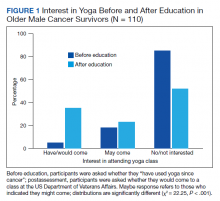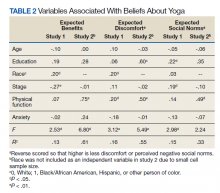Enhancing Access to Yoga for Older Male Veterans After Cancer: Examining Beliefs About Yoga
Background: Yoga is an effective clinical intervention for cancer survivors. Most studies of the positive effects of yoga on cancer patients report on predominantly middle-aged women with breast cancer. Less is known about the use of yoga in older adults, veterans, and those from diverse racial or ethnic backgrounds.
Methods: We examined strategies to enhance access to yoga in older veterans after cancer, focusing on education (study 1) and intervention (study 2). Study 1 included 110 participants with a median (SD) age of 64.9 (9.4) years who were mostly male (99%) cancer survivors who were interviewed 12 months after their cancer diagnosis. Study 2 included 28 participants with a median (SD) age of 69.2 (10.9) years who were mostly male (96%) cancer survivors who participated in a yoga program within 3 years of their cancer diagnosis. Standardized interviews assessed interest in and barriers to yoga while self-reporting assessed health-related quality of life and beliefs about yoga.
Results: In study 1, interest in yoga increased from 5.5 to 31.8% ( χ 2 = 22.25, P < .001) following education. In open-ended questions 4 themes related to negative beliefs or barriers emerged: lack of knowledge or skepticism, disinterest or dislike, physical health barriers, and logistical barriers. In study 2, beliefs were more positive following intervention for expected benefits ( t = 4.44, P < .001), discomfort ( t = 4.92, P < .001), and social norms ( t = 4.38, P < .001) related to yoga. Physical function improved after participation in a yoga class, especially for those with higher beliefs in yoga prior to class. Age was not associated with beliefs about yoga in either sample.
Conclusions: A portion of older veterans who are cancer survivors were interested in yoga but faced access barriers. Implications for practice and research include increasing knowledge about yoga benefits and addressing physical health and logistical barriers to enhance access to yoga for older veterans.
Results
Study 1
The sample of 110 military veterans was mostly male (99.1%) with a mean (SD) age of 64.9 (9.4) years (range, 41-88)(Table 1). The majority (70.9%) described their race/ethnicity as White, non-Hispanic followed by Black/African American (18.2%) and Hispanic (8.2%) persons; 50.0% had no more than a high school education. The most common cancer diagnoses were colorectal (50.9%), head and neck (39.1%), and esophageal and gastric (10.0%) and ranged from AJCC stages I to IV.
When first asked, the majority of participants (78.2%) reported that they were not interested in yoga, 16.4% reported they might be interested, and 5.5% reported they had tried a yoga class since their cancer diagnosis. In contrast, 40.9% used exercise, 32.7% used meditation, 14.5% used physical or occupational therapy, and 11.8% used massage therapy since their cancer diagnosis.
After participants were provided the brief scripted education about yoga, the level of interest shifted: 46.4% not interested, 21.8% interested, and 31.8% definitely interested, demonstrating a statistically significant shift in interest following education (χ2 = 22.25, P < .001) (Figure 1). Those with the most positive beliefs about yoga were most likely to indicate interest. Using the BAYS 3-item survey, the mean (SD) for the definitely interested, might be interested, and not interested groups was 15.1 (3.2), 14.1 (3.2), and 12.3 (2.5), respectively (F = 10.63, P < .001).
A multivariable regression was run to examine possible associations between participants’ demographic characteristics, clinical characteristics, and beliefs about yoga as measured by the 3 BAYS items (Table 2). Higher expected health benefits of yoga was associated with identifying as
Six themes were identified in qualitative analysis of semistructured interviews reflecting older veterans’ beliefs about yoga, which were grouped into the following suprathemes of positive vs negative beliefs (Figure 2). Exemplar responses appear in Table 3.
Study 2 Intervention Sample
This sample of 28 veterans was mostly male (96.4%) with a mean (SD) age of 69.2 (10.9) years (range, 57-87). The majority (89.3%) described their race as White, followed by Black/African American (10.7%); no participants self-identified in other categories for race/ethnicity. Twelve veterans (42.9%) had no more than a high school education. The most common cancer diagnosis was genitourinary (35.7%) and the AJCC stage ranged from I to IV.











